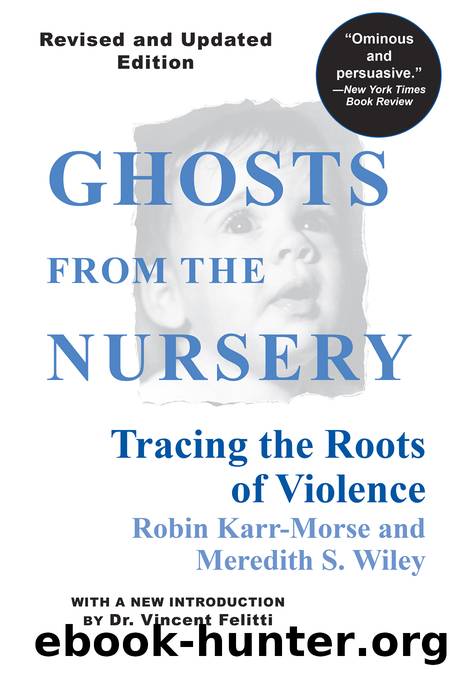Ghosts from the Nursery by Robin Karr-Morse

Author:Robin Karr-Morse
Language: eng
Format: epub
Publisher: Grove Atlantic
Published: 2013-12-09T16:00:00+00:00
THAT OLD FAMILIAR FEELING:
LEARNING TO REGULATE EMOTIONS
Besides meeting the baby’s basic physical needs for food, shelter, and warmth, early caregiving behavior sends subtle messages of emotional comfort—or not—to the infant’s brain. Not only are physical systems such as digestion being regulated by the mother’s proximity and her provision of food, touch, etc., but the child’s neurologically based emotional systems are also setting their balance points. A mother’s ability to accurately interpret her baby’s cues and her response to those cues has immediate repercussions on the modulation of the stress-related neurotransmitters (e.g., norepinephrine) and on key centers of emotion such as the limbic system in the baby’s brain. The baby left to cry for long intervals or the baby whose cry is greeted with a slap is undergoing a very different experience emotionally and neurologically than the child whose cries result in immediate soothing. A caregiver’s predictable responses to the baby’s distress signals and her sensitive pacing of activities to engage her infant when the baby is alert are not only patterning the emotional behavior we can observe, but also actually building connections and modulating neurochemicals in the baby’s brain. This becomes the biological foundation for the child’s later efforts to maintain emotional balance.
Schore’s research on the neurobiology of emotional regulation focuses not only on the orbitofrontal system in the brain, which links the neocortex to the limbic system and modulates emotions, but also on the right hemisphere of the brain, where emotions of distress, sadness, and disgust originate. Dependent on the caregiver’s ability to accurately and sensitively respond, the baby communicates her internal state through a repertoire of emotional signals. Over time, the actual physical structure and neurochemical profile of the baby’s brain come to reflect the caregiver’s responses. According to Schore, the sensitivity and responsiveness of the mother are “literally shaping and fine-tuning the circuits in the infant’s limbic system, which will ultimately be responsible for the regulation of affect.”23 Through mutual interaction, the mother actually re-creates in the baby a psychological and physiological state similar to her own.
The baby left alone to cry or whose cries result in unpredictable or abusive responses may never learn what it feels like to maintain or regain balance through thoughtfully timed external soothing. This is our first model for a constructive, self-consoling pattern when faced with strong negative emotions. Fear or rage may frequently overwhelm a child who has not learned emotional regulation skills. Explosive aggression, freezing, or self-destructive behavior may result from a child’s disorganized efforts to handle strong feelings without a constructive experiential “map.”
As they mature, all children—like all adults—will be exposed to situations that will generate strong negative emotions of fear, anger, jealousy, or frustration. But here, in our first relationship, is the seat of our physiological and emotional patterning in regulating those emotions. A 1995 study by Dr. Angela Scarpa Scerbo, psychologist at Virginia Polytechnic Institute, and Dr. David Kolko, of the University of Pittsburgh, suggests that the ability to regulate emotion in childhood serves as a protective factor against one’s own aggressive behavior.
Download
This site does not store any files on its server. We only index and link to content provided by other sites. Please contact the content providers to delete copyright contents if any and email us, we'll remove relevant links or contents immediately.
When Breath Becomes Air by Paul Kalanithi(7252)
Why We Sleep: Unlocking the Power of Sleep and Dreams by Matthew Walker(5636)
Paper Towns by Green John(4163)
The Immortal Life of Henrietta Lacks by Rebecca Skloot(3819)
The Sports Rules Book by Human Kinetics(3581)
Dynamic Alignment Through Imagery by Eric Franklin(3481)
ACSM's Complete Guide to Fitness & Health by ACSM(3459)
Kaplan MCAT Organic Chemistry Review: Created for MCAT 2015 (Kaplan Test Prep) by Kaplan(3418)
Introduction to Kinesiology by Shirl J. Hoffman(3297)
Livewired by David Eagleman(3113)
The River of Consciousness by Oliver Sacks(2988)
Alchemy and Alchemists by C. J. S. Thompson(2907)
The Death of the Heart by Elizabeth Bowen(2895)
Descartes' Error by Antonio Damasio(2727)
Bad Pharma by Ben Goldacre(2722)
The Gene: An Intimate History by Siddhartha Mukherjee(2487)
Kaplan MCAT Behavioral Sciences Review: Created for MCAT 2015 (Kaplan Test Prep) by Kaplan(2483)
The Fate of Rome: Climate, Disease, and the End of an Empire (The Princeton History of the Ancient World) by Kyle Harper(2429)
The Emperor of All Maladies: A Biography of Cancer by Siddhartha Mukherjee(2427)
